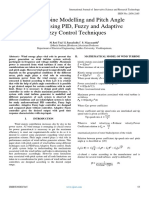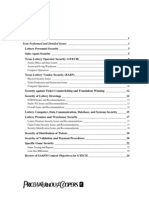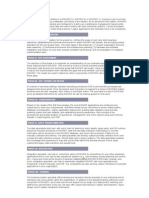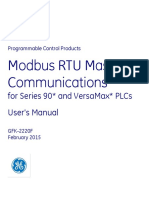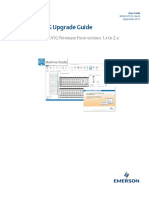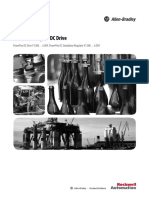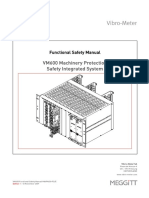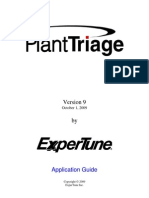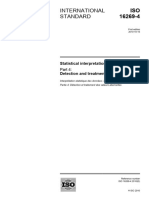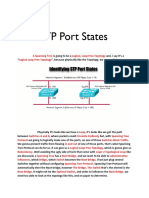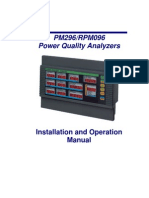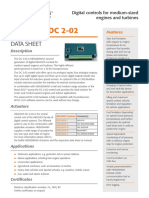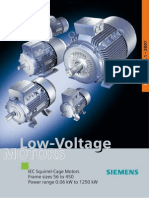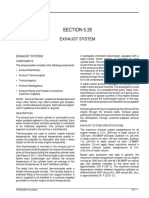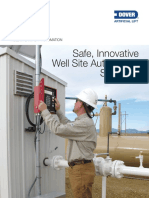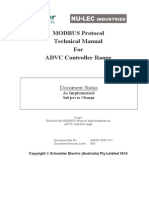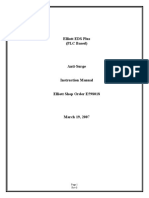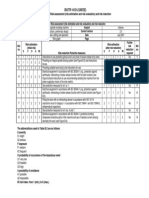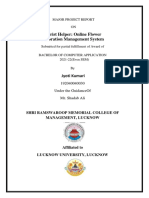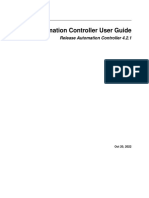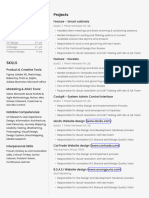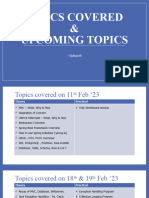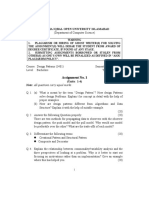SIMOREG 6RA70 DC MASTER Electronics: Speed Control With CEMF Feedback
SIMOREG 6RA70 DC MASTER Electronics: Speed Control With CEMF Feedback
Uploaded by
MancamiaicuruCopyright:
Available Formats
SIMOREG 6RA70 DC MASTER Electronics: Speed Control With CEMF Feedback
SIMOREG 6RA70 DC MASTER Electronics: Speed Control With CEMF Feedback
Uploaded by
MancamiaicuruOriginal Title
Copyright
Available Formats
Share this document
Did you find this document useful?
Is this content inappropriate?
Copyright:
Available Formats
SIMOREG 6RA70 DC MASTER Electronics: Speed Control With CEMF Feedback
SIMOREG 6RA70 DC MASTER Electronics: Speed Control With CEMF Feedback
Uploaded by
MancamiaicuruCopyright:
Available Formats
SIMOREG 6RA70 DC MASTER Electronics
Up to this point we have looked at the power components of a DC Drive necessary to control the speed of a DC motor. The actual control of these components is accomplished with electronic hardware and technology software. Speed Control with CEMF Feedback Speed control is one mode of operation. The drive will attempt to maintain a constant speed regardless of the loads torque. A speed reference is input into a ramp function generator which applies reference voltage to the speed controller over a specified period of time. This allows a smoother acceleration of the motor and connected load. The output of the speed controller is routed to the firing circuit, which controls the amount of voltage applied to the armature. You will recall that Va (applied voltage) = IaRa + CEMF. IaRa is proportional to load and is generally 10% of nameplate armature voltage at 100% load. Therefore, as load torque/ current varies between 0 and 100%, IaRa varies from 0 to 50 VDC for a 500 VDC armature. Va and Ia are constantly monitored. Ra is measured during the comissioning and tuning of the drive. Because Va, Ia, and Ra are known values, CEMF (Ea) can be precisely calculated. CEMF is proportional to speed and the speed controller uses this value to calculate actual speed. Speed control with CEMF feedback can only be used on applications where the motor operates between zero and base speed. CEMF feedback provides approximately 2-5% speed regulation.
54
Speed Control with Tach Feedback
A tachometer can be used when a more accurate measurement of speed is needed, or when the motor will be operated above base speed. A measurement of actual speed is returned to the speed controller. The speed controller will make armature voltage adjustments to maintain constant speed with variations in load. If, for example, load is suddenly increased the motor will slow, reducing speed feedback. The speed controller will output a higher signal to the current controller, which will increase the firing angle of the firing circuit. The resulting increased armature voltage applies more torque to the motor to offset the increased load. Motor speed will increase until it is equal with the speed reference setpoint. When the motor is rotating faster than desired speed armature voltage is reduced. In a four-quad drive DC armature voltage could momentarily be reversed to slow the motor at a faster rate to the desired speed. Several tachs can be used with the SIMOREG 6RA70. DC tachs can provide approximately 0.10 to 2% regulation. Digital (pulse) tachs can provide approximately 0.10 to 0.25% regulation. These values vary depending on the tach and the operating conditions.
55
Current Measurement
The drive monitors current, which is summed with the speed control signal at the current controller. The drive acts to maintain current at or below rated current by reducing armature voltage if necessary. This results in a corresponding reduction in speed until the cause of the overcurrent is removed.
Torque Control
Some applications require the motor to operate with a specific torque regardless of speed. The outer loop (speed feedback) is removed and a torque reference is input. The current controller is effectively a torque controller because torque is directly proportional to current.
56
Tuning the Drive
A feature of the SIMOREG 6RA70 DC MASTER is the ability to self tune for a given motor and associated load. An improperly tuned control may result in an excessive speed overshoot when changing from one speed to another. Oscillations can occur which contribute to system instability.
A properly tuned drive will have an initial overshoot of approximately 43% and settle into a new speed quickly. This provides a stable system with quick response.
The SIMOREG 6RA70 DC MASTER has three self-tuning routines to match the performance of the drive to the controlled motor and associated load. Armature Tuning tunes the drive to the motor characteristics Speed Tuning tunes the drive to the connected load CEMF Tuning tunes the drive for field weakening
57
CUD1 Board
The CUD1 board is the main control board for the SIMOREG 6RA70. This board contains the necessary software and hardware interfaces for operating the drive in speed or torque control. It has input and output connections for wiring the control devices of various functions such as start/stop pushbuttons and speed potentiometer. The CUD1 board has comprehensive diagnostics for troubleshooting. CUD1 also contains the necessary software for self-tuning. Programmable binary outputs, used to indicate the condition of the drive, are available on X171. Binary inputs are also available to start and stop the drive on X171. In addition, there are two programmable binary inputs for such functions as reverse and jog. The 6RA70 accepts analog inputs for speed control on X174. Programmable analog outputs on X175 provide meter indication of various drive parameters such as current and voltage. A motor temperature switch can be connected to X174 and is used to stop the drive if the motor becomes overheated. Connections are also available on X173 for a digital tach.
58
Typical Connections
The following diagram shows a typical connection used to operate the drive. A normally open (NO) contact is used to start and stop the drive.
Alternately, pushbuttons can be used to start and stop the drive.
59
Programming and Operating Sources
SIMOREG 6RA70 drives can be programmed and operated from various sources, such as the PMU, OP1S, or other SIMATIC HMI device such as the TP170A, TP170B, OP27 , or MP370. In addition to these, various methods of serial communication is available through RS232 or RS485 connections. These will be discussed later in this section with the option boards. The PMU can be used alone or with the OP1S. The OP1S can be mounted directly on the PMU or up to 200 meters away with an external power supply. Parameters, such as ramp times, minimum and maximum speed, and modes of operation are easily set. The changeover key (P) toggles the display between a parameter number and the value of the parameter. The up and down pushbuttons scroll through parameters and are used to select a parameter value, once the P key sets the parameter. The OP1S has a numbered key pad for direct entry.
SIMATIC HMI Devices
Another, more robust option, is a SIMATIC HMI device such as the TP170A. The TP170A uses a touch-sensitive screen for control and monitoring. It is powered from the drive and standard PROFIBUS connections.
60
CUD2 Expansion Board
The CUD2 is typically selected when additional inputs and outputs (I/O) are required. CUD2 I/O is selectable. An advantage to the CUD2 expansion board is that it mounts directly on the CUD1 and requires no additional hardware. The CUD2 provides four optically isolated binary inputs, four selectable binary inputs to ground, two analog inputs, one analog input for motor temperature evaluation, two binary outputs, and one serial interface. In addition to the expanded I/O, the CUD2 provides a parallel interface for paralleling up to six power modules.
61
EB1 and EB2 Expansion Boards
EB1 and EB2 are half-sized expansion boards that provide a number of additional I/O possibilities. EB1 has three binary inputs and four bidirectional binary I/O. Bidirectional I/O can be configured as a binary input or output. One of the analog inputs is used as a voltage or current reference input. Two of the analog inputs can also be configured as binary inputs. EB2 has two binary inputs, one analog input, one analog output, and four relay contacts. Three of the contacts are normally open (NO) and one of the contacts can be configured as normally open (NO) or normally closed (NC).
I/O Isolated Binary Inputs Binary Inputs Bidirectional Binary I/O Analog Inputs Analog Outputs Relay (Binary) Outputs Serial Interface Parallel Converter Interface CUD2 4 4 0 2 2 2 1 1 EB1 0 3 4 3 2 0 0 0 EB2 0 2 0 1 1 4 0 0
T400 Technology Board
The T400 is an option board that is used to provide specialized features for applications, such as winders, tension control, position control, and hoisting gear. In addition to applying built-in technology functions, users familiar with the Siemens PLC software SIMATIC STEP-7 can also implement their own process functions.
To implement the various control functions required by specific applications the T400 has two analog outputs, five analog inputs, two binary outputs, eight binary inputs, four bidirectional binary inputs/outputs, two incremental encoder inputs, and two serial interfaces. 62
Communications
One of the strong points of the SIMOREG 6RA70 is its serial interface capabilities, which makes it easy to integrate the drive with other automation components. Communication options are available for PROFIBUS-DP , SIMOLINK, CAN, and DeviceNet communications. The SLB communication board is used for peer-to-peer communication with other Siemens drives via SIMOLINK. SIMOLINK is a high speed fiber optic ring bus that allows various data to be passed from one drive to the next. Communication is not limited to the SIMOREG 6RA70. SIMOLINK can also communicate between Siemens AC drives such as the MASTERDRIVE MC and MASTERDRIVE VC.
SLB
CBP2
PROFIBUS-DP is an open bus standard for a wide range of applications in various manufacturing and automation applications. Siemens DC drives can easily communicate with other control devices such as programmable logic controllers (PLCs) and personal computers (PCs) through the PROFIBUSDP communication system and other various protocols. The CBP2 board is required to communicate via PROFIBUS-DP .
63
CBC
ISO is a federation of standards organizations from over 100 countries that develops voluntary standards for business, science, and technology. The official name is Organization Internationale de Normalisation, also known in the United States as the International Organization for Standardization. The CBC communication board is used to communicate with CAN protocol, which is an ISO standard (ISO 11898) for serial data communications. CAN protocol was initially developed in 1986 for the automotive industry. Today communication with CAN protocol can also be found in other industrial automation applications. One device, such as a PLC or computer, acts as a master. SIMOREG drives equipped with CBC boards and other controllable devices configured for CAN act as slaves. CAN uses a simple twisted pair of wires for transmission of control and parameter value data between SIMOREG drives with CBC boards.
64
CBD
The CBD communication board is used to communicate with DeviceNet. DeviceNet is another communication protocol that was developed based on the CAN technology. DeviceNet provides a low-level network for DeviceNet enabled devices such as sensors, motor starters, and drives to communicate with higher-level devices such as computers and PLCs. DeviceNet can read the state of devices, such as on/off, as well as start and stop motors (motor starters). SIMOREG 6RA70 DC MASTERs equipped with a CBD board can be added to a DeviceNet network. A DeviceNet enabled master device can control the operation, such as start, stop, accel, and decel.
SBP
Digital tachometers (encoders) can be used to measure the actual speed of a motor. The SBP encoder board can be also be used to monitor an external encoder, such as might be connected to the driven machine.
65
Electronics Box
The electronics box contains the CUD1 board (main control board) and option boards. The CUD1 board is plugged into slot 1. There are several option boards available, which will be discussed later in this section. Option boards are automatically recognized by the drive. Up to six boards can be installed in the electronics box. A Local Bus Adapter (LBA) is required if mounting positions 2 or 3 are needed. In addition, adapter boards (ADB) are necessary for slots D, E, F , and G when utilizing the half-size option boards.
Mounting Option Boards
66
There are a few rules that must be followed when mounting option boards: Option boards may be plugged into positions 2 or 3, however, position 2 must be filled first. When used, a technology board (T400) is always installed in position 2. If a communication board (CBP2, CBC. or CBD) is used with a technology board the communication board is placed in slot G. It is unnecessary and not possible to use expansion boards EB1 and EB2 in conjunction with the technology board T400. T400 has its own expanded inputs and outputs (I/O). It is unnecessary and not possible to use the pulse encoder board (SBP) or the SIMOLINK communication board (SLB) in conjunction with T400. T400 has provision to connect an encoder. A maximum of two supplementary boards of the same type may be used in one drive. For example, no more than two communication boards or two expansion boards can be used.
The following chart shows the mounting positions for CUD1 and option boards.
Board CUD1 CUD2 CBP2 CBC CBD SLB SBP T400 EB1 EB2 LBA No No Yes Yes Yes Yes Yes Yes Yes Yes ADB No No Yes Yes Yes Yes Yes No Yes Yes Location 1 Yes Yes No No No No No No No No Location 2 D E No No No No Yes Yes Yes Yes Yes Yes Yes Yes Yes Yes Yes Yes Yes Yes Yes Location 3 F G No No No No Yes Yes Yes Yes Yes Yes Yes Yes Yes Yes No Yes Yes Yes Yes
67
Review 6 1. 2. ____________ is the designation of the main electronic control board in the SIMOREG 6RA70 DC MASTER. A ____________ ____________ ____________ is required when mounting option boards in the electronics box. Position ____________ must be filled first when installing option boards. ____________ tuning tunes a drive to the motor characteristics. Technology board T400 can be installed in location ____________ . An advantage of the CUD2 expansion board is that it mounts directly on ____________ and requires no additional hardware. ____________ expansion board has the most bidirectional binary I/O. a. CUD2 b. EB1 c. EB2 8. 9. ____________ is used to communicate with PROFIBUS-DP. ____________ is used to communicate with other Siemens drives via SIMOLINK.
3. 4. 5. 6.
7.
10. A second digital tachometer is connected to the drive through an ____________ board when T400 is not used.
68
You might also like
- Wind Turbine Modelling and Pitch Angle Control Using PID, Fuzzy and Adaptive Fuzzy Control TechniquesDocument6 pagesWind Turbine Modelling and Pitch Angle Control Using PID, Fuzzy and Adaptive Fuzzy Control TechniquesInternational Journal of Innovative Science and Research TechnologyNo ratings yet
- Ecuaciones para Curva de Conductores y MotoresDocument6 pagesEcuaciones para Curva de Conductores y MotoresCarlos Lovera Rodriguez100% (1)
- Iso 17799 Security Audit Example PWCDocument26 pagesIso 17799 Security Audit Example PWCMancamiaicuruNo ratings yet
- Maximo Implementation PhaseDocument2 pagesMaximo Implementation Phaselhamelin100% (1)
- p147 Page JonesDocument5 pagesp147 Page JonesBudimanNo ratings yet
- Model-Based Design of An LQR Controller For A Single Inverted Rotary PendulumDocument1 pageModel-Based Design of An LQR Controller For A Single Inverted Rotary PendulumSahil BhattNo ratings yet
- Simoreg Dc-Master: Operating InstructionsDocument9 pagesSimoreg Dc-Master: Operating Instructionsanas raddawiNo ratings yet
- Simoreg 6RA70 ParametersDocument178 pagesSimoreg 6RA70 Parametersalpha1ahNo ratings yet
- Eletrobras-Programas CEPEL-Electrical Networks DepartmentDocument12 pagesEletrobras-Programas CEPEL-Electrical Networks DepartmentOruatNo ratings yet
- Manual MSE5010Document103 pagesManual MSE5010junniorbsbNo ratings yet
- GFK2220F Modbus RTU Master Comm User Manual 20150202 Web PDFDocument50 pagesGFK2220F Modbus RTU Master Comm User Manual 20150202 Web PDFSudipto MajumderNo ratings yet
- Simoreg F 30 Fault (Text) - PLCSDocument7 pagesSimoreg F 30 Fault (Text) - PLCSstudskirbyNo ratings yet
- MLSC2 - WoodwardDocument198 pagesMLSC2 - WoodwardCosme RodolfoNo ratings yet
- Microsoft PowerPoint - 02 CommissioningDocument10 pagesMicrosoft PowerPoint - 02 CommissioningคุณทองดำNo ratings yet
- Upgrade AMS 6500 ATG Firmware From Version 1.x To 2.xDocument12 pagesUpgrade AMS 6500 ATG Firmware From Version 1.x To 2.xPaulo LeiteNo ratings yet
- Msa 300Document10 pagesMsa 300ferchllNo ratings yet
- Rockwell PowerFlex DC User GuideDocument406 pagesRockwell PowerFlex DC User Guideleonardo_melo_costaNo ratings yet
- MRD1-T Transformer Differential Protection SystemDocument58 pagesMRD1-T Transformer Differential Protection SystemBenigno Sayaboc TaradelNo ratings yet
- Vibrometer VM 600Document34 pagesVibrometer VM 600ali shetaNo ratings yet
- SPA-ZC400 Tob 755450 ENd PDFDocument8 pagesSPA-ZC400 Tob 755450 ENd PDFsemajamesNo ratings yet
- Eurotherm Chessel 6100a PDFDocument2 pagesEurotherm Chessel 6100a PDFRhondaNo ratings yet
- Simoreg ErrorDocument30 pagesSimoreg Errorphth411No ratings yet
- AC31 ConnectDocument40 pagesAC31 ConnectNenoNo ratings yet
- ApplicationGuide PDFDocument17 pagesApplicationGuide PDFsteam100deg1658No ratings yet
- WEG CFW11M Referencia Rápida de ParámetrosDocument162 pagesWEG CFW11M Referencia Rápida de ParámetrosPabloAlv100% (1)
- D Agent - 1 - Work 310 S Upload 172179AE1Document36 pagesD Agent - 1 - Work 310 S Upload 172179AE1Mor BenNo ratings yet
- ADRE DatasheetDocument31 pagesADRE DatasheetEduard RamosNo ratings yet
- TSXPBY100E - Premium Profibus ManualDocument66 pagesTSXPBY100E - Premium Profibus Manualdobryraul100% (1)
- Sicam Io Module EngDocument139 pagesSicam Io Module EngConstantin Ninov100% (1)
- Catálogo - Relé de Proteção Spam 150C - ABB (ING) PDFDocument8 pagesCatálogo - Relé de Proteção Spam 150C - ABB (ING) PDFclaudenir85No ratings yet
- Joslyn Hi-Voltage Overhead Reclosers and Switches PDFDocument46 pagesJoslyn Hi-Voltage Overhead Reclosers and Switches PDFFlogisto79No ratings yet
- GFK1645JDocument704 pagesGFK1645JArvind DeepNo ratings yet
- BRU13778 T20 Data Sheet - 04Document2 pagesBRU13778 T20 Data Sheet - 04robert timothyNo ratings yet
- A5 Liqi CatalogoDocument4 pagesA5 Liqi CatalogoPaladini100% (1)
- RD-10-03 - Device Profile - Modbus Protocol (Calisto 5 - Calisto 9) Rev-1-13Document15 pagesRD-10-03 - Device Profile - Modbus Protocol (Calisto 5 - Calisto 9) Rev-1-13tiburcio asencio sevillanoNo ratings yet
- Iso 16269-4-2010 - 7500Document3 pagesIso 16269-4-2010 - 7500vijayNo ratings yet
- Master Drives T 400Document241 pagesMaster Drives T 400aqccc120No ratings yet
- 2 - Spanning Tree Protocol Ports StatesDocument8 pages2 - Spanning Tree Protocol Ports StatesthulasiramaswamyNo ratings yet
- 3500 - AC and DC Power SuppliesDocument29 pages3500 - AC and DC Power SuppliestestvsptestNo ratings yet
- Ic 693 Cpu 313Document5 pagesIc 693 Cpu 313mubashersaeedNo ratings yet
- PM296 ManualDocument77 pagesPM296 ManualrajakprashantNo ratings yet
- EPower 029669 5 PDFDocument14 pagesEPower 029669 5 PDFrajabharath12No ratings yet
- Es60 26 ND9000 SMC ValmetDocument20 pagesEs60 26 ND9000 SMC ValmetJosé Angel ZabaletaNo ratings yet
- Ifix 6.0Document63 pagesIfix 6.0sugesusNo ratings yet
- Apergy PCS Ferguson 8000 Series Controllers Brochure 3Document8 pagesApergy PCS Ferguson 8000 Series Controllers Brochure 3ojrfgmrfNo ratings yet
- MR MESSKO - Digital Thermometer EPT202Document4 pagesMR MESSKO - Digital Thermometer EPT202OpscenarJMD100% (1)
- Cimplicity - System Sentry Operation ManualDocument89 pagesCimplicity - System Sentry Operation ManualEduardo DiazNo ratings yet
- 505E Digital Governors For Extraction Steam TurbinesDocument180 pages505E Digital Governors For Extraction Steam TurbinesrogerioNo ratings yet
- Powerflex DC Stand Alone Regulator and Gate Amplifier: User ManualDocument90 pagesPowerflex DC Stand Alone Regulator and Gate Amplifier: User ManualFrancisco RiveraNo ratings yet
- Iq DatasheetDocument8 pagesIq Datasheetapi-170472102No ratings yet
- Modelo HelenosDocument2 pagesModelo HelenosproesantNo ratings yet
- D81-1 1007 enDocument653 pagesD81-1 1007 enalejovallesNo ratings yet
- Drive Composer - Software Tools - ABBDocument6 pagesDrive Composer - Software Tools - ABBIrlan LeiteNo ratings yet
- Test Suite Siprotec 5Document27 pagesTest Suite Siprotec 5Guillermo BetancourtNo ratings yet
- Service Manual: HCD-BX7/DX7/DX7JDocument70 pagesService Manual: HCD-BX7/DX7/DX7Jjama35No ratings yet
- DECS 150 EnglishDocument258 pagesDECS 150 EnglishJoseNo ratings yet
- SECTION 5.35: Exhaust SystemDocument30 pagesSECTION 5.35: Exhaust SystemLUISA FERNANDA TORRES MANOSALVANo ratings yet
- PCS Ferguson SCADA BrochureDocument8 pagesPCS Ferguson SCADA BrochureJhon Lino Paravicini GonzalesNo ratings yet
- MODBUS ADVC Controller Range PDFDocument14 pagesMODBUS ADVC Controller Range PDFv1a2n3e4No ratings yet
- Elliott EDS Plus (PLC Based)Document16 pagesElliott EDS Plus (PLC Based)Oleg YaniNo ratings yet
- Danfuss Fc300 Doc MG33MD02Document221 pagesDanfuss Fc300 Doc MG33MD02Sohel SikderNo ratings yet
- AC Servo Controllers AMC10, AMC11 and AMC12: ... When Motors Must Be ControlledDocument4 pagesAC Servo Controllers AMC10, AMC11 and AMC12: ... When Motors Must Be Controllederik12342507No ratings yet
- Enet pp005 - en eDocument5 pagesEnet pp005 - en eMancamiaicuruNo ratings yet
- ISO 14121-2-2007 Risk AssessmentDocument1 pageISO 14121-2-2007 Risk AssessmentMancamiaicuruNo ratings yet
- Protective Relays and Trip UnitsDocument23 pagesProtective Relays and Trip UnitsMancamiaicuruNo ratings yet
- Pmma 3Document8 pagesPmma 3MancamiaicuruNo ratings yet
- Displaying Values of The Sentron Pac3200/Pac4200 in Wincc 7.0 Sp1 Via EthernetDocument5 pagesDisplaying Values of The Sentron Pac3200/Pac4200 in Wincc 7.0 Sp1 Via EthernetMancamiaicuruNo ratings yet
- Florist Helper: Online Flower Decoration Management System: Major Project Report ONDocument11 pagesFlorist Helper: Online Flower Decoration Management System: Major Project Report ONsalmanNo ratings yet
- Automation Controller User GuideDocument342 pagesAutomation Controller User GuidePritapiranti SolusiNo ratings yet
- Software Process Models: Farooq Ahmed, FAST-NU, LahoreDocument19 pagesSoftware Process Models: Farooq Ahmed, FAST-NU, LahoreMusab ZainNo ratings yet
- File Tracking SystemDocument109 pagesFile Tracking Systemradshan2967% (3)
- Load Dispatch Centre: By-Siddharth KumarDocument16 pagesLoad Dispatch Centre: By-Siddharth KumarSIDDHARTHNo ratings yet
- Naukri GauravSharma (2y 6m)Document2 pagesNaukri GauravSharma (2y 6m)Arup NaskarNo ratings yet
- TopicsDocument8 pagesTopicsSidharth PallaiNo ratings yet
- Distributed Mining and Monitoring (DMM) Quality Assurance PlanDocument18 pagesDistributed Mining and Monitoring (DMM) Quality Assurance PlanAB GammerNo ratings yet
- P01-06 - Control Loop - V8.1 - S0915 - ENDocument18 pagesP01-06 - Control Loop - V8.1 - S0915 - ENnelle69No ratings yet
- Engine Control PDFDocument1 pageEngine Control PDFYazied AndreazNo ratings yet
- Question Bank For Customer Relationship Management PaperDocument1 pageQuestion Bank For Customer Relationship Management PaperVinay SinghNo ratings yet
- GV CS Remy-CointreauDocument3 pagesGV CS Remy-CointreauhuydangryanNo ratings yet
- Intersystems Communication: Unit 1Document80 pagesIntersystems Communication: Unit 1tauraiNo ratings yet
- Tian 2 - Simatic SistemiDocument20 pagesTian 2 - Simatic SistemiMersad Islamovich'No ratings yet
- W11 Tutorial Solutions Chapter 13Document5 pagesW11 Tutorial Solutions Chapter 13mamnunbd100% (4)
- Traffic StudyDocument13 pagesTraffic StudyRiyad ArafatNo ratings yet
- Frontend Programming Syllabus 2024Document18 pagesFrontend Programming Syllabus 2024omer.tapdiqovNo ratings yet
- TCIB1 Introduction R14Document19 pagesTCIB1 Introduction R14Emmanuel Uchenna ChukwuNo ratings yet
- Importance of Software Testing in The Process of Software DevelopmentDocument6 pagesImportance of Software Testing in The Process of Software Developmentda6789121No ratings yet
- Allama Iqbal Open University Islamabad: Assignment No. 1Document4 pagesAllama Iqbal Open University Islamabad: Assignment No. 1gulzar ahmadNo ratings yet
- Tech Notice-EEC C1 FAULTSDocument3 pagesTech Notice-EEC C1 FAULTSWaqar Ahmad KhanNo ratings yet
- ACS880 Drive Modules Catalog 3AUA0000115038 RevL EN 14-12-2020 LowresDocument120 pagesACS880 Drive Modules Catalog 3AUA0000115038 RevL EN 14-12-2020 LowresYongwonNo ratings yet
- B23 B22 B25 B26 B17 B27 B28 B20 B19 B4 B2 B31: Position of Parts in Engine Compartment (LHD 2ZR-FE Except TMMMS Made)Document4 pagesB23 B22 B25 B26 B17 B27 B28 B20 B19 B4 B2 B31: Position of Parts in Engine Compartment (LHD 2ZR-FE Except TMMMS Made)Albert BriceñoNo ratings yet
- Cloud Computing and Internet of Things PQ1-PQ2Document22 pagesCloud Computing and Internet of Things PQ1-PQ2Melina JaminNo ratings yet
- Incident HandlingDocument1 pageIncident HandlingfilipeNo ratings yet
- Developer PD - Python DjangoDocument4 pagesDeveloper PD - Python DjangoPrograma ProsperidadeNo ratings yet
- Engrane Balanceadora Mitsubishi L200 2.5 2011-2015Document2 pagesEngrane Balanceadora Mitsubishi L200 2.5 2011-2015Alvaro RAMIREZ GARCIANo ratings yet

